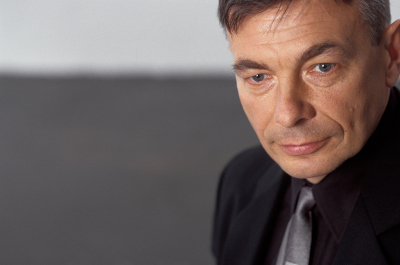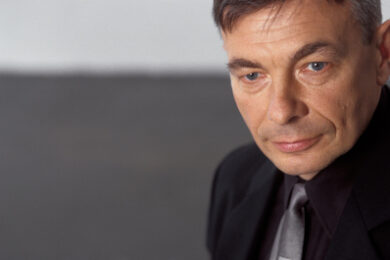Former Kraftwerk percussionist Karl Bartos brings his Live Cinema A/V project to London this Friday (Mar 13).
The Quietus had the chance to speak to Bartos, who spent 16 years with the seminal robot-pop troupe, ahead of this weekend’s date – the full interview will run on the site tomorrow, but you can find an extract below.
Heading to O2-based club Matter with decks/vocoder operator Mathias Black, Bartos will be performing his new programme ‘The Rhythmic Screen’, pitting films, video loops and animated pictograms against his musical back catalogue to forge a new reflexive rhythm between the two.
Details of the event – headlined by house and techno DJ Dubfire – can be found at the Matter website, while an extract from the interview we mentioned is below.
It’s exciting to hear that you’re coming back over to the UK soon. Can you tell us what we can expect at your performance at Matter?
Karl Bartos: “It will be an audio visual show and will last for 90 minutes. We’re going to play some hits from the past of course, which I was involved in like ‘Numbers’, ‘Computer World’, ‘The Man Machine’, ‘The Robots’ and some newer tracks from my record Communication and some other highlights.”
For those who perhaps aren’t au fait with Communication can you give us an idea of how that material sounds?
KB: “Well it’s electronic instruments of course! We have a reduced pictogram style in sound and vision because I did some video clips along with some of the tracks which I’m going to play. It’s all about how our society has changed from a word-based society to a picture-based society and to show what it’s all about I’m using pictograms; the language of signs that we know from transport or airports and I’ve made an animation of it."
And I believe that also that the live cinema AV concept has links to the classic age of cinema?
KB: “In a way, yes. I’m using some quotations. I’m going to play ‘The Model’ which is taken from Kraftwerk’s repertoire and I’m going to mix it with some scenes from a movie which was made in London in the 60s, Blow Up, so I have some scenes from the shooting but I have rearranged them. If you put certain sequences out of context, suddenly the visual layers lose their sense. Really, I’m treating the visuals like music in a way. We are meant to receive our daily reality through our eyes and everything we see has to make sense in order to survive. If we receive through our ears the sound, which has an emotional impact on us, if you start to treat a picture like sound or like music, like it was pure form, it loses its narrative – you treat the visual layer like music and that is what is very interesting to me."
It is it a difficult project to take on the road?
KB: “This project makes a lot of sense to us because we are only two people and we can travel very light. We’ve been touring through England with six or seven people which is very expensive and we need more money. Commercially this is much more interesting for us because we can go for one day to England and come back the next day. It is very much like the concept of the DJ performance but now audio visual. And because I’m doing the visuals and sing along with some hits it’s interesting for me because I won’t get bored like I would if it was a normal DJ set! But this is because I’m not a DJ – I feel like a musician – a musician who uses pictures instead of an instrument. It allows me to improvise with visuals and that is much more fun than just putting four to the floor.”



